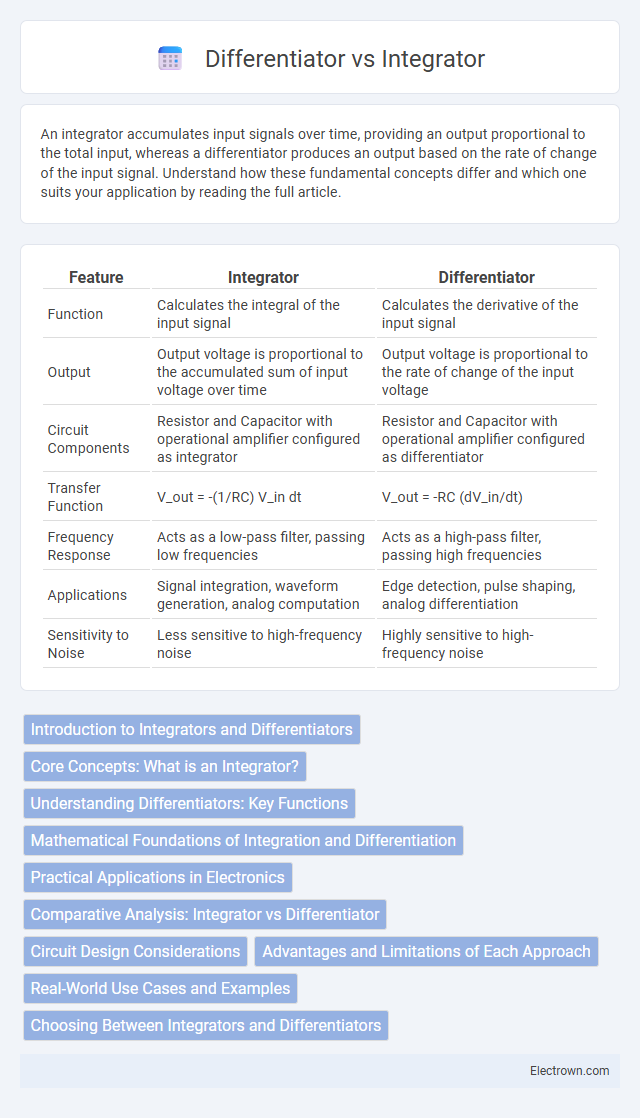An integrator accumulates input signals over time, providing an output proportional to the total input, whereas a differentiator produces an output based on the rate of change of the input signal. Understand how these fundamental concepts differ and which one suits your application by reading the full article.
Table of Comparison
| Feature | Integrator | Differentiator |
|---|---|---|
| Function | Calculates the integral of the input signal | Calculates the derivative of the input signal |
| Output | Output voltage is proportional to the accumulated sum of input voltage over time | Output voltage is proportional to the rate of change of the input voltage |
| Circuit Components | Resistor and Capacitor with operational amplifier configured as integrator | Resistor and Capacitor with operational amplifier configured as differentiator |
| Transfer Function | V_out = -(1/RC) V_in dt | V_out = -RC (dV_in/dt) |
| Frequency Response | Acts as a low-pass filter, passing low frequencies | Acts as a high-pass filter, passing high frequencies |
| Applications | Signal integration, waveform generation, analog computation | Edge detection, pulse shaping, analog differentiation |
| Sensitivity to Noise | Less sensitive to high-frequency noise | Highly sensitive to high-frequency noise |
Introduction to Integrators and Differentiators
Integrators and differentiators are fundamental analog circuits used in signal processing, where integrators output the accumulated sum of an input signal over time, effectively performing mathematical integration. Differentiators produce an output proportional to the rate of change of the input signal, simulating differentiation. Both circuits commonly utilize operational amplifiers to achieve precise integration and differentiation functions in analog electronics.
Core Concepts: What is an Integrator?
An integrator is a fundamental component in calculus and signal processing that accumulates the input signal over time, producing an output proportional to the integral of the input function. It effectively sums the area under the curve of the input signal, which is essential for understanding changes in cumulative quantities such as displacement from velocity or total charge from current. Your ability to use an integrator is crucial for analyzing systems where accumulation and continuous summation of values over time are required.
Understanding Differentiators: Key Functions
Differentiators calculate the rate of change of an input signal, effectively highlighting rapid variations and transitions in data. In signal processing and control systems, these key functions help detect edges and sudden shifts, making differentiators essential for improving precision and responsiveness. Your ability to analyze dynamic behaviors greatly improves by understanding how differentiators emphasize high-frequency components over steady-state signals.
Mathematical Foundations of Integration and Differentiation
Integration and differentiation are fundamental operations in calculus, rooted in the concepts of limits, functions, and infinitesimals. Differentiation calculates the instantaneous rate of change of a function by evaluating the limit of average rates over infinitesimal intervals, formalized through the derivative definition. Integration, defined by the Riemann or Lebesgue integral, accumulates the total quantity under a curve by summing infinitesimal contributions, serving as the inverse process of differentiation according to the Fundamental Theorem of Calculus.
Practical Applications in Electronics
Integrator circuits are widely used in analog signal processing for tasks such as waveform generation, analog computation, and filtering, converting input voltage signals into proportional output voltages representing the integral over time. Differentiator circuits find practical application in edge detection, high-pass filtering, and pulse shaping, detecting rapid changes in input signals to produce output voltages representing the derivative. Understanding the roles of integrator and differentiator circuits enables you to design precise electronic systems for control, communication, and instrumentation.
Comparative Analysis: Integrator vs Differentiator
An integrator accumulates input signals over time, producing an output proportional to the integral of the input, while a differentiator responds to the rate of change, generating an output proportional to the derivative of the input. Integrators are essential in applications requiring signal smoothing and area calculation, whereas differentiators excel in edge detection and rapid change measurement. Understanding these differences helps you select the right analog circuit for filtering, control systems, or signal processing tasks.
Circuit Design Considerations
Circuit design considerations for integrators and differentiators include selecting appropriate feedback components to achieve desired frequency response and stability. Integrator circuits typically use capacitors in the feedback loop to accumulate input signals over time, while differentiators employ capacitors at the input to emphasize rapid voltage changes. Your choice of resistor and capacitor values directly impacts noise sensitivity, bandwidth, and phase shift, crucial for optimizing performance in analog signal processing applications.
Advantages and Limitations of Each Approach
Integrators excel in noise reduction and signal smoothing, making them ideal for applications requiring cumulative data analysis but suffer from drift and baseline errors over time. Differentiators provide high sensitivity to rapid changes and edge detection in signals, yet they amplify noise and are less effective for steady-state conditions. Choosing between integrators and differentiators depends on balancing the need for noise suppression versus sensitivity to signal transitions in specific signal processing tasks.
Real-World Use Cases and Examples
Integrator circuits are essential in analog computers for summing input signals over time, widely used in signal processing applications like audio effects and control systems. Differentiator circuits excel in edge detection and motion sensing, making them crucial in robotics and real-time system feedback loops. Understanding these differences helps you select the right circuit for applications demanding precise signal analysis or temporal integration.
Choosing Between Integrators and Differentiators
Choosing between integrators and differentiators depends on your specific signal processing needs: integrators are ideal for generating a signal proportional to the cumulative sum, making them perfect for applications like signal smoothing or low-pass filtering. Differentiators provide an output proportional to the rate of change of the input signal, which is useful for edge detection and high-pass filtering. Evaluating your system's frequency response requirements and noise sensitivity will guide your decision to optimize performance.
integrator vs differentiator Infographic

 electrown.com
electrown.com